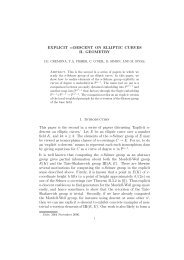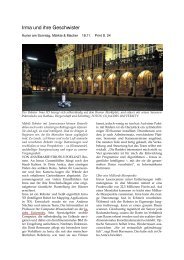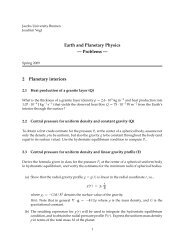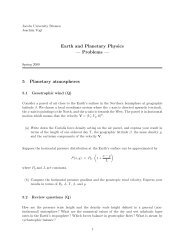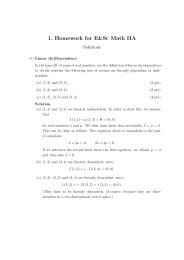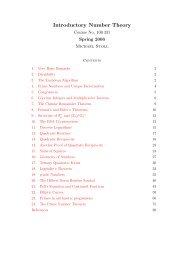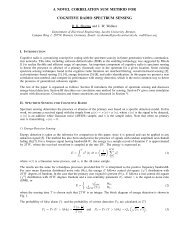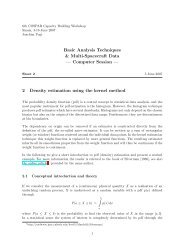Space Plasma Physics ? Problems ? 4 Frozen-in magnetic flux
Space Plasma Physics ? Problems ? 4 Frozen-in magnetic flux
Space Plasma Physics ? Problems ? 4 Frozen-in magnetic flux
You also want an ePaper? Increase the reach of your titles
YUMPU automatically turns print PDFs into web optimized ePapers that Google loves.
Jacobs University Bremen<br />
Joachim Vogt<br />
Spr<strong>in</strong>g 2010<br />
4 <strong>Frozen</strong>-<strong>in</strong> <strong>magnetic</strong> <strong>flux</strong><br />
<strong>Space</strong> <strong>Plasma</strong> <strong>Physics</strong><br />
— <strong>Problems</strong> —<br />
4.1 Perpendicular <strong>magnetic</strong> field <strong>in</strong> two-dimensional flows (Q)<br />
Recall the hydro<strong>magnetic</strong> theorem:<br />
∂B<br />
∂t<br />
= ∇ × (V × B) .<br />
Show that <strong>in</strong> planar flows where the <strong>magnetic</strong> field is straight and vertical, it satisfies a twodimensional<br />
cont<strong>in</strong>uity equation. More specifically, assume Vz ≡ 0, Bx ≡ By ≡ 0, ∂/∂z = 0, and<br />
then demonstrate that<br />
∂Bz<br />
∂t + ∇ · (BzV) = 0 .<br />
4.2 Geoeffective electric field and transpolar potential (Q)<br />
The so-called geoeffective electric field is the motional electric field associated with the southward<br />
component (negative Bz) of the <strong>in</strong>terplanetary <strong>magnetic</strong> field <strong>in</strong> the solar w<strong>in</strong>d flow.<br />
(a) How large is the geoeffective electric field for Bz = −5 nT and regular solar w<strong>in</strong>d flow<br />
conditions (V = 400 km/s) ?<br />
(b) What is the associated potential drop across the diameter (∼ 40 RE) of the magnetosphere ?<br />
Which value do you get if due to reconnection at the dayside magnetopause about 10% of<br />
this potential couples <strong>in</strong>to the magnetosphere ?<br />
4.3 Walén equation (E)<br />
In this problem you are supposed to comb<strong>in</strong>e the hydro<strong>magnetic</strong> theorem and the mass cont<strong>in</strong>uity<br />
equation to f<strong>in</strong>d an expression for the variation of B/ϱ along streaml<strong>in</strong>es.<br />
(a) Rearrange the hydro<strong>magnetic</strong> theorem to obta<strong>in</strong> an equation for the variation dB/dt of<br />
the <strong>magnetic</strong> field B along the flow.<br />
1
(b) Rearrange the mass cont<strong>in</strong>uity equation to f<strong>in</strong>d the rate of change of the <strong>in</strong>verse mass<br />
density along streaml<strong>in</strong>es, i.e., write down an equation for dϱ −1 /dt.<br />
(c) Comb<strong>in</strong>e your results from parts (a) and (b) to derive the Walén equation:<br />
d<br />
dt<br />
<br />
B<br />
ϱ<br />
=<br />
<br />
B<br />
· ∇V<br />
ϱ<br />
that gives the rate of change of B/ϱ <strong>in</strong> ideal plasmas.<br />
H<strong>in</strong>ts and explanations<br />
In ideal plasmas, the evolution of the <strong>magnetic</strong> field B is governed by the hydro<strong>magnetic</strong> theorem<br />
∂B/∂t = ∇×(V × B) where V denotes the plasma bulk velocity. The substantial (or convective<br />
or total) time derivative is given by<br />
d<br />
dt<br />
∂<br />
= + V · ∇ .<br />
∂t<br />
The mass cont<strong>in</strong>uity equation is usually written <strong>in</strong> the form<br />
where ϱ denotes mass density.<br />
∂ϱ<br />
∂t<br />
+ ∇ · (ϱV) = 0<br />
4.4 Vector fields, streaml<strong>in</strong>es, and flow (E)<br />
Consider the follow<strong>in</strong>g vector fields <strong>in</strong> two dimensions.<br />
V(r) =<br />
V(r) =<br />
V(r) =<br />
<br />
1<br />
, (1)<br />
y<br />
<br />
1<br />
2xy/(1 + x2 <br />
, (2)<br />
)<br />
<br />
U(y)<br />
, (3)<br />
0<br />
V(r) = W (r) ˆϕ . (4)<br />
Here (x, y) denote cartesian coord<strong>in</strong>ates, and (r, ϕ) are polar coord<strong>in</strong>ates. U(y) and W (r) are<br />
arbitrary functions of y and r, respectively.<br />
(a) Construct the flows of the vectors fields.<br />
(b) Sketch a representative set of streaml<strong>in</strong>es. Here you may assume U(y) = y and W (r) = r.<br />
2
H<strong>in</strong>ts and explanations<br />
Recall that the streaml<strong>in</strong>es (= field l<strong>in</strong>es = <strong>in</strong>tegral curves) r(t) of a vector field V(r) are<br />
solutions of ˙r(t) = V(r(t)). This system of ODEs is usually supplemented by an <strong>in</strong>itial condition<br />
of the form r(t = 0) = r0. The <strong>in</strong>itial value problem corresponds to the task of f<strong>in</strong>d<strong>in</strong>g the<br />
streaml<strong>in</strong>e that passes through the po<strong>in</strong>t r0.<br />
The collection of streaml<strong>in</strong>es constitutes the so-called flow F = F(r, t) of the vector field V<br />
def<strong>in</strong>ed through<br />
∂F<br />
= V(r(t)) and F(r, 0) = r .<br />
∂t<br />
For brevity, we write ˙ F = ∂F/∂t.<br />
If the flow F(r, t) is known, the solution of the <strong>in</strong>itial value problem<br />
can be conveniently written <strong>in</strong> the form:<br />
˙r(t) = V(r(t)) and r(t = 0) = r0<br />
r(t) = F(r0, t) .<br />
4.5 Interplanetary <strong>magnetic</strong> field l<strong>in</strong>es (H-12p)<br />
The field l<strong>in</strong>es of the average <strong>in</strong>terplanetary <strong>magnetic</strong> field (IMF) are usually referred to as<br />
Parker spirals. In the equatorial plane, the IMF is conveniently written as<br />
B = B(r) = Br(r)ˆr + Bλ(r) ˆ λ<br />
where λ denotes the azimuth and r is radial distance. We are <strong>in</strong>terested <strong>in</strong> the scal<strong>in</strong>g behavior<br />
of Br and Bλ with r.<br />
In the follow<strong>in</strong>g, we construct Parker spirals through an essentially stationary solution of the<br />
hydro<strong>magnetic</strong> theorem. The radial solar w<strong>in</strong>d outflow comb<strong>in</strong>ed with the effect of solar rotation<br />
yields an effective plasma velocity <strong>in</strong> the equatorial plane with components Vr and Vλ <strong>in</strong> radial<br />
and <strong>in</strong> azimuthal direction, respectively. The radial component is assumed to be constant and<br />
equal to the solar w<strong>in</strong>d speed Vsw.<br />
(a) What does ∇ · B = 0 imply for the radial component of B = B(r) ? Write down Br <strong>in</strong><br />
terms of r and the field value Br0 at a reference distance R0.<br />
(b) Assum<strong>in</strong>g that the Sun rotates at an angular rotation rate Ω, how does Vλ scale with radial<br />
distance ?<br />
(c) With the help of the frozen-<strong>in</strong> <strong>flux</strong> concept, express Bλ <strong>in</strong> terms of the supposedly constant<br />
radial component Vr = Vsw and the azimuthal component Vλ(r) from part (b).<br />
(d) Construct and then solve a differential equation for the <strong>in</strong>terplanetary field l<strong>in</strong>es. Sketch<br />
their geometrical shape.<br />
3
4.6 Open and closed magnetosphere (H-20p)<br />
The scalar potential of a <strong>magnetic</strong> dipole <strong>in</strong> spherical coord<strong>in</strong>ates (r, ϑ, λ) is given by<br />
3 cos ϑ<br />
Φd(r, ϑ) = Bd∗R<br />
r2 where Bd∗ is a reference field value. The parameter R denotes a reference radius, e.g., the radius<br />
of a magnetized planet. The dipole moment is assumed to be aligned with the polar (z) axis.<br />
In this problem we consider the superposition of such a dipole field and a uniform field<br />
Bh = Bh∗ˆz ,<br />
so |Bh∗| is the field strength. The sign of Bh∗ controls the orientation of Bh.<br />
(a) Compute the dipole field Bd = −∇Φd. If Bd is supposed to correspond to the geo<strong>magnetic</strong><br />
field, and R = RE is the radius of the Earth, what is the mean<strong>in</strong>g of the parameter Bd∗ ?<br />
Should it be positive or negative ?<br />
(b) Write the uniform field <strong>in</strong> spherical coord<strong>in</strong>ates and f<strong>in</strong>d a scalar potential Φh = Φh(r, ϑ)<br />
so that Bh = −∇Φh. If Bh is supposed to correspond to the North-South component<br />
of the <strong>in</strong>terplanetary <strong>magnetic</strong> field, should the parameter Bh∗ be positive or negative<br />
to yield reconnection at the dayside magnetopause ? In the follow<strong>in</strong>g the reconnection<br />
case is referred to as an open magnetosphere, and the opposite orientation gives a closed<br />
magnetosphere.<br />
(c) Construct the superposed potential and field <strong>in</strong> spherical coord<strong>in</strong>ates:<br />
Φ = Φd + Φh , B = Bd + Bh .<br />
(d) In the closed magnetosphere case, there exist a sphere where the radial field component<br />
vanishes. What are the implications for the field l<strong>in</strong>e topology ? Express the radius of<br />
the sphere <strong>in</strong> terms of the parameters Bd∗, Bh∗ and R. If Bd∗ and R are chosen to be<br />
consistent with the geo<strong>magnetic</strong> field, what is the numerical value of Bh∗ that yields the<br />
actual dayside magnetopause stand-off distance for the radius of that sphere ? Discuss.<br />
(e) Plot the field l<strong>in</strong>es of the comb<strong>in</strong>ed field B for the closed magnetosphere case.<br />
H<strong>in</strong>t: A convenient approach is through the construction of an appropriate stream function<br />
Ψ = Ψ(r, ϑ) for the axisymmetric field B. Try the ansatz B = ∇Ψ × ∇λ. Field l<strong>in</strong>es are<br />
contours of Ψ.<br />
(f) Plot the field l<strong>in</strong>es of the comb<strong>in</strong>ed field B for the open magnetosphere case.<br />
(g) In the open magnetosphere case, the area where surface <strong>magnetic</strong> <strong>flux</strong> connects to <strong>in</strong>terplanetary<br />
space def<strong>in</strong>es the so-called polar cap. Determ<strong>in</strong>e the open<strong>in</strong>g angle of the polar<br />
cap <strong>in</strong> terms of the model parameters Bd∗, Bh∗ and R.<br />
Submission due date for homework problems: 8 March 2010<br />
4



